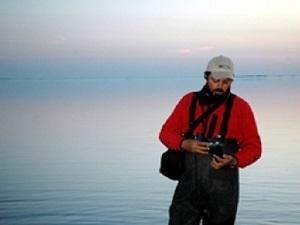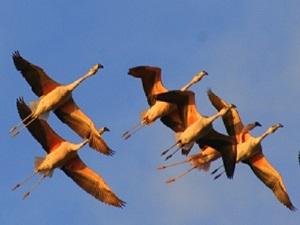Enrique Javier Derlindati
Other projects
9 Feb 2007
Conservation of High Andes Flamingo Species (Phoenicoparrus andinus and P. jamesi): Habitat Use and Activity Patterns in Two Contrasting Wetland Systems of Argentina
This project aims to produce a science-based, long-term and effective conservation strategy for sites used by Andean Flamingos during the non-breeding season, we plan to conduct inventories and ecological studies directed to identifying and analysing microhabitat characteristics associated with the behaviour and distribution of this species. We also plan to develop a conservation strategy for the Andean Flamingo taking into account the ecological processes at local and regional scales and their interactions with human activities.

Enrique working at Melincué. ©M. Romano.
Andean flamingo (Phoenicoparrus andinus) is the rarest flamingo in the world with 34,000 individuals. It is restricted to the Andes wetlands during the breeding season and use lowland wetlands during the non-breeding season. There are many studies that estimated its populations and characterized the limnology of wetlands in the Andes. Nevertheless, there is no similar study from the lowland wetlands. Moreover, patterns of habitat use at local scale are poorly known, especially in their winter range. A key lowland wetland is Melincué, which in winter supports more than 15% of the total Andean flamingo population. It is located in the Pampas plains of Argentina. This wetland has been proposed as a Ramsar site and included within the Network of priority sites for the Conservation of High Andes Flamingos. In our first RSG project, we recorded hundreds of individuals performing courtship displays at Melincué.

Flying Andean flamingos at Melincué dusk. ©E. Derlindati.
It is likely that this behaviour conditions the reproductive success of this species at the Andes. In order to understand the role of the lowland wetlands in the annual cycle of the Andean flamingos, we must monitor their abundance and record habitat use and activity patterns at this key site during the whole non-breeding period (April-September). In Melincué we are going to carry out a winter survey by recording flamingo abundances and activity patterns in the different microhabitats used by this species. We will stand at one or more survey points on the shore and use spotting scopes to count individuals and record the microhabitats used.
In each microhabitat, we will take samples to measure several variables: temperature, pH, O2, conductivity, diversity and abundance of plankton. We will record the behaviour of Andean Flamingos by choosing an individual within a flock and recording the time spent doing each activity through 3 minutes.
This process will be repeated with at least 100 random individuals in three time periods: early morning, noon and dusk. This will allow us to construct time budgets for flamingos in different habitats. We will analyse if there are differences among microhabitats by using generalized linear models and if there are differences in flamingo activities at different times of the day by using multivariate techniques. We will analyse whether flamingo activities are associated with climatic variables by using Mantel correlation tests, and also evaluate if some flamingo activities are associated with some climatic variables by using univariate correlation tests.